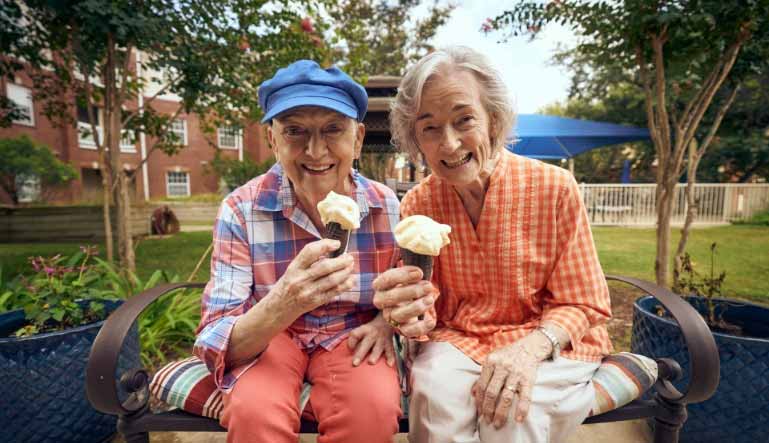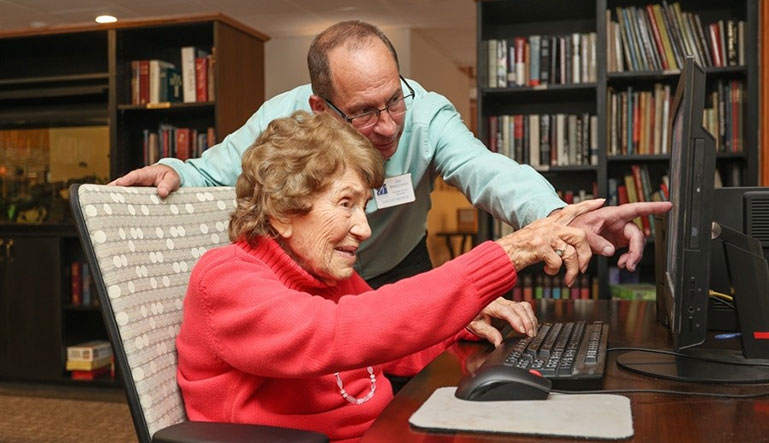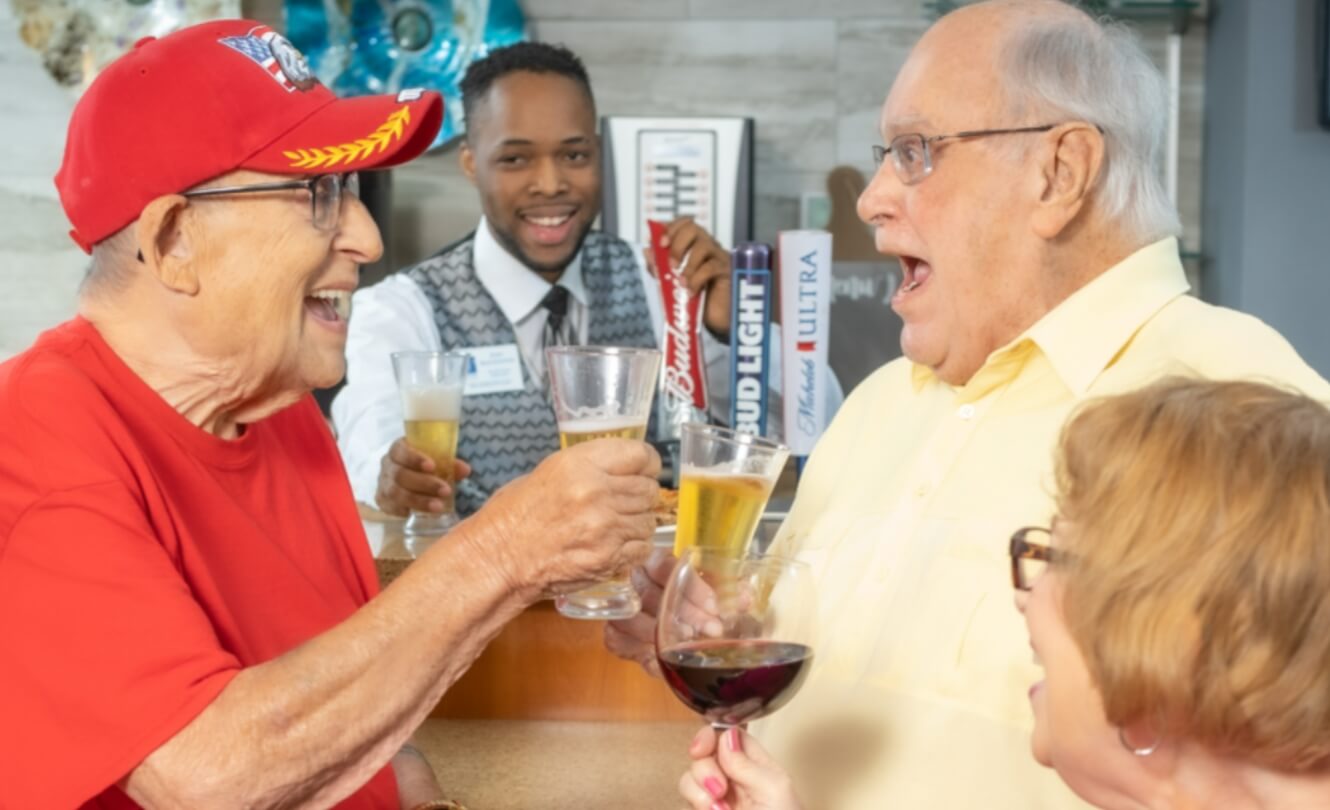Independent living communities, also known as retirement communities, are a senior housing option designed with the active adult in mind. They are often a good fit for older adults seeking freedom from the burdens of homeownership such as home maintenance and repairs because housekeeping tasks and maintenance chores are handled by the independent living community team members. This allows independent living residents to have more time to fully enjoy their retirement. Independent living comes in several forms:
- Apartments in a dedicated independent living community or on the campus of a larger continuing care community
- Maintenance-free villas or small cottages that are part of a retirement community
An Independent Living community nurtures an older adult’s interests and hobbies. These often include hosting travel groups, life-enrichment activities, continuing education classes and wellness programs. Many Independent Living residents also enjoy opportunities volunteering in the community.
Table of Contents
What is the average age of an independent living resident?
Independent living community residents range in age from the mid-50s to eighties and beyond.
What are considered independent living skills?
Independent living communities center around adults who are able to accomplish daily living tasks, also known as Activities of Daily Living (ADLs), without assistance. Most senior living providers and health professionals group ADLs into the following categories:
Common Categories of Activities of Daily Living (ADLs)
|
| Dressing |
Being able to dress and undress, choose appropriate clothing for the weather and have the dexterity to manage buttons, zippers and other fasteners. |
| Eating |
The ability to feed oneself (not including cooking). |
| Bathing or Showering |
This includes grooming activities such as shaving and brushing teeth and hair. |
| Continence |
Being able to control bowels and bladder or to manage incontinence independently. |
| Toileting |
The ability to use the toilet and get to the toilet independently. |
| Transferring |
This refers to functional mobility. For most people, functional mobility is being able to walk, get in and out of bed, and into and out of a chair. If the person is not ambulatory, they should be able to transfer from bed to wheelchair on their own. |
There is a secondary category of activities of daily living that go a step further, known as Instrumental Activities of Daily Living (IADLs). These are more complex tasks that often build on basic ADLs, but require a certain amount of physical dexterity, sound judgment, and organizational skills. IADLs are not essential functions of living like ADLs, though they are key to being able to live independently.
Instrumental activities of daily living typically include the following:
Common Instrumental Activities of Daily Living (IADLs)
|
| Managing finances |
Paying bills and managing financial assets. |
| Managing transportation |
Either by driving, using public transportation or by organizing other means of transport. |
| Shopping and meal preparation |
Grocery shopping, cooking and any other activity required to prepare your own meals. |
| Housecleaning and home maintenance |
Keeping one’s living space reasonably clean and tidy and overall maintaining of the home. |
| Managing communication |
Using the telephone and managing mail. |
| Managing medications |
Obtaining medications and taking them as directed. |
For adults who are able to perform ADLs and IADLs without assistance, independent living can be a great option in retirement.
What are the benefits of independent living?
Moving to an independent senior living community offers a host of benefits for active older adults. Here are some of the things older adults like most about independent living communities:
- No maintenance or repairs: Independent living frees residents of the burdens of home ownership and maintenance. Moving to an independent living community means no more shoveling, mowing the lawn, fixing home appliances, or worrying about other maintenance issues.
- Healthy meal options: Whether due to certain medications affecting appetite or requiring a special or more bland diet, finding appealing food or preparing food can become a burden for older adults. Independent living communities offer a variety of healthy meal options that still please the palate. Some communities accommodate restricted diets. For those who love to cook or make their own food for health reasons, some independent living communities offer a kitchen or kitchenette in each apartment so residents can continue to cook if they’d like to.
- Amenities and conveniences: Depending on the independent living community, residents have access to a host of amenities and conveniences to make retirement life easier and more enjoyable. Housekeeping, transportation, trash removal, a beauty/barber shop, and meal plans are just a few standard services. Some independent living communities even have a concierge to help make arrangements for theater tickets, dry cleaning, travel plans, and more. In addition to amenities on campus, residents get to enjoy the amenities of the surrounding neighborhood. From access to tranquil walks in nature to bustling shopping days in the city, there are independent living communities in neighborhoods to suit many different lifestyles.
- Socialization: Maintaining connections with other people is a crucial part of a balanced and happy life, especially as we age. Senior isolation is a serious issue for adults in retirement, and independent senior living communities offer meaningful ways to connect with friends and neighbors each day. Whether a quick cup of coffee in the dining room before heading over to morning devotionals or an afternoon of games, the built-in opportunities for socialization are a primary reason seniors move to independent living.
- Safety and Security: As loved ones age, family members begin to worry about their safety at home. Independent living communities provide a safe and secure environment for older adults. From having staff onsite around the clock, to fire suppression systems and an emergency call system, seniors can feel safe living alone and know that help is right there day or night if needed.
- Personal Assistance: Some independent living communities also have programs in place to offer assistance with personal care – this is a bit different from a full-on assisted living community (more about that below!). This allows an older adult to remain independent longer.
What’s the Difference between Independent Living and Assisted Living?
Independent and assisted living are both senior living communities with some key differences: Independent living is for older adults who are able to execute Activities of Daily Living (ADLs) without help. Assisted Living refers to a community for older adults who need a little extra help with activities of daily living to live their most independent life. Independent living is perfect for older adults looking to move on from home ownership but who can and want to live on their own. Assisted living is ideal for older adults who need help with daily activities but who don’t need continuous medical supervision. Here’s what each type of senior living entails in a bit more detail:
- Independent/Retirement Living Communities. Independent senior living communities aim to provide a maintenance-free lifestyle, and often offer dining programs, housekeeping, and laundry. A wide range of life enrichment activities and events make it easier for independent living residents to continue to enjoy an engaged, productive lifestyle.
- Assisted Living Communities. These senior living communities offer a step up in services for seniors who need help with medication, bathing, dressing, and personal care. They provide restaurant-style dining and a selection of social activities, physical fitness programs, and other life enrichment activities.
- Independent Living Residents are mobile, able to manage day-to-day life on their own, don’t want the hassle of keeping up a home, and are drawn to the social activities and stress-free living that independent living can provide.
- Assisted Living Residents are seniors who need a little more help in their day, but who don’t require complex medical care. On their own, they may forget to take their medications or struggle to get to doctor’s appointments, and benefit from assistance with personal needs like bathing and dressing.
What’s the difference between independent living and home care?
Independent living refers to a community geared toward active, mobile older adults who want to continue to live an independent and socially connected lifestyle without the burden of home maintenance. Home care refers to older adult assistance brought into the home to help with everything from housekeeping and daily chores to more intensive medical care. Home care is sometimes also referred to as in-home care, custodial care, personal care, companion care, or homemaker services. Home care is generally used as a way to assist older adults that may be dealing with chronic illness, mobility issues, disabilities, or surgery recovery, and is a means to allow them to stay at home instead of moving into assisted living or a nursing home.
What’s the difference between independent living and senior apartments?
In some instances, an independent living community is structured as senior apartments, but the main difference is that senior apartments not affiliated with an independent living community are primarily focused on providing affordable senior housing for older adults, though there are luxury senior apartment communities as well. Senior apartments under an independent living community umbrella have added benefits and amenities like community activities, on-site services like a hair salon, dining options, and easy access to healthcare. Senior apartments allow independent older adults to maintain their active lifestyle without the upkeep of home ownership in either instance.
What’s the difference between independent living and a 55+ community?
Although there’s no ‘official’ definition of independent living vs. a 55+ community, there are key differences in how they tend to be described or categorized. In general, independent living communities offer a higher level of amenities and service, making for a stress-free living experience, whereas 55+ communities’ amenities are more varied depending on the complex. Another major difference is that in 55+ communities, it’s common for residents to own their home, whereas in independent living communities, residents are most often renting. You can see some common differences between independent living and 55+ communities below.
55+ Communities vs. Independent Living Comparison Table
|
55+ Communities |
Independent Living |
| Services Provided |
55+ complexes offer the convenience of providing maintenance of the building, grounds and apartment. |
Independent living communities offer a stress-free lifestyle where the hassles of life—like home upkeep, cooking and cleaning—are taken care of. |
| Amenities |
There may be a clubhouse with planned social activities in a 55+ community. The availability and quality of amenities varies widely by community. |
Convenient access to on-site shared dining spaces, pools, libraries, game rooms and a wide variety of community activities are common in independent living communities. |
| Own or rent? |
There are many 55+ communities where residents own their houses or condominiums, while others may offer rental properties. Home ownership is often governed by a homeowners association (HOA) and includes an HOA fee. |
Independent living residents generally rent their houses or apartments, although the “rent” includes much more than a roof over one’s head. While renting is more typical of independent living, neither community type is exclusively one or the other. |
| How much does it cost? |
The cost to rent a senior apartment varies and can range from low-income senior apartments, to standard rate, to luxury senior apartments. |
Communities vary widely in terms of cost, which can range from $2,000 to $5,000 or more a month. A number of factors determine the cost, like the type of community and location. |
Who is independent living best suited for?
Independent Living is a great senior living option for older adults who can manage mostly on their own but don’t want the hassle of keeping up a home. Independent living is perfect for seniors who are mobile, who don’t suffer from major health or cognitive issues, and who find the social aspect of independent living activities and amenities appealing.
What does independent living cost?
Independent living communities vary widely in terms of cost, which can range from $2,000 to $5,000 or more a month. When considering everything that is included when moving to independent living, what may initially seem expensive ends up being a great deal. Services covered in the monthly fee at an independent living community include things that would cost much more when purchased separately, like lawn care, property maintenance, and housekeeping.
A number of factors determine what you pay for independent living. Whatever your budget, chances are there is an independent living community that meets your needs.
Some factors that influence the cost of independent living include:
Type of independent living community – A stand-alone independent living community might offer fewer amenities but may cost less than an independent living community located on the campus of a continuing care community. Many independent living communities are priced similarly to other apartments in the area.
Location – As with other housing types, location plays a factor in cost. Major cities typically have a higher cost of living which translates to higher monthly fees. Rates will be higher in more desirable neighborhoods. Square footage of accommodations at an independent living community will also influence the monthly fee.
To learn more about pricing different senior living options, download our FREE Guide to the Cost of Senior Living eBook.
Is Independent Senior Living the same as a Retirement Community?
Independent living communities are often also called retirement communities. The terms are interchangeable and refer to a community for seniors that has amenities and services that make life easier and more social while maintaining independence.
How to Know When to Transition to Independent Living
As you or a loved one approaches retirement, feelings toward home ownership can shift, and priorities in life can change. It’s not uncommon for empty nesters to want to downsize, or for retirees to want to move closer to their children and grandchildren. Housekeeping and home maintenance may begin to feel more like a burden than a joy, and it can be easy to start feeling isolated or have difficulty maintaining a vibrant social life. Independent living helps take away the worry associated with living at home (for both residents and their adult children) such as safety concerns, and provides an enriching and active environment for seniors to relax and enjoy the retirement they’ve worked so hard for. If you find that you are feeling like you’d like to take some of the stressors of home maintenance, cooking or cleaning, and other day-to-day priorities off your shoulders, considering a move to independent living could be the right thing for you.
Talking About Moving to Independent Living with a Loved One
Adults that move to independent living communities are still mobile, active, and able to tend to their needs without assistance. Unlike adults who are struggling to take care of themselves and may need to consider assisted living, retirees who could benefit from independent living are able to manage their lives in their current homes. But you may notice that your loved one is getting overwhelmed with things like taking care of the lawn, scheduling repairs or keeping up with housekeeping. Perhaps your mom has cooked for the family her whole life and you can tell she’d really enjoy being able to have cooking as an option but not a requirement anymore. Or maybe as your parents lose members of their social circle you sense some loneliness and isolation. These are great segues to bringing up the possibility of independent living with your loved ones. Reassuring them that they will still maintain full independence but just have certain things taken care of that can make life easier and more vibrant can help encourage a transition that can benefit the whole family.
What Support is Included at an Independent Senior Living Community?
Support across independent living communities generally includes some or all of the following:
- home maintenance and groundskeeping
- housecleaning
- healthy on-site dining options, including the ability to have kitchens/kitchenettes if desired
- senior activities and events
- laundry service
- transportation assistance
- 24/7 security and on-call help
Different independent living communities have different amenities. Some independent living communities are part of a larger senior care organization, and in these instances, there may be more readily available medical support or the ability to transition into assisted living or make use of assisted living services on the same campus if the need arises. For other standalone independent living communities, these may function more like a luxury apartment complex.
Maintaining an Active Senior Lifestyle in Independent Living
Whether you’re into arts and crafts or running marathons, independent living communities offer ample opportunities for residents to continue to enjoy the activities they love, and discover new ones! Here are just some of the ways independent living communities help residents enjoy an active senior lifestyle:
- Special events and social gatherings
- Cards and games
- Movie nights
- Senior fitness classes and senior personal training
- Coordinated group trips and outings
- Arts and crafts
- On-site dining
- Clubs and activities around hobbies – birdwatching, nature walks, etc.
- Events for families to enjoy together
- And more
How to Find the Right Independent Living Facility for Your Needs
With so many options available, and many with similar grounds and amenities, finding the independent living community that’s the right fit can feel daunting. More important than amenities, though, is finding a place to be able to settle into and really be a part of, to feel comfortable socially and accepted for who you are.
As you research different independent living communities, take your time browsing websites, reading testimonials, and be sure to schedule a virtual or in-person tour for your top choices if that’s an option for you.
We offer personalized senior living virtual tours over Zoom and FaceTime that include a guided visit through the neighborhood, meetings with team members, and a one-on-one with a sales counselor to answer any questions you may have. This is not only a safe option, but can be invaluable for those considering a long distance move who might not be nearby.
Find an Independent Living Community Near You
Finding an independent living community that’s perfect for you is a major decision and one that can have an enormously positive impact on your life. Want to learn more about independent living at Five Star? Find a senior living community near you.
Contact Us Today










